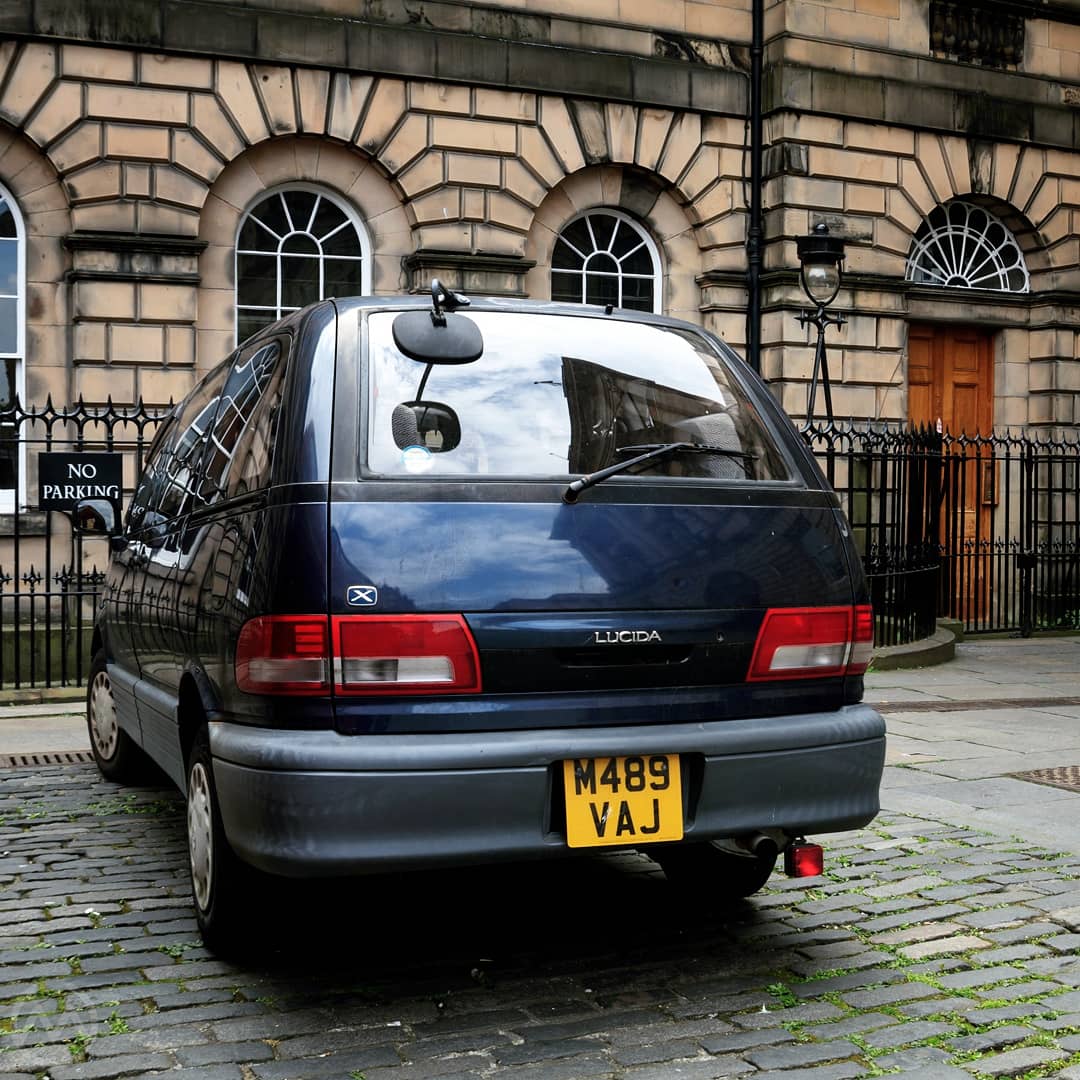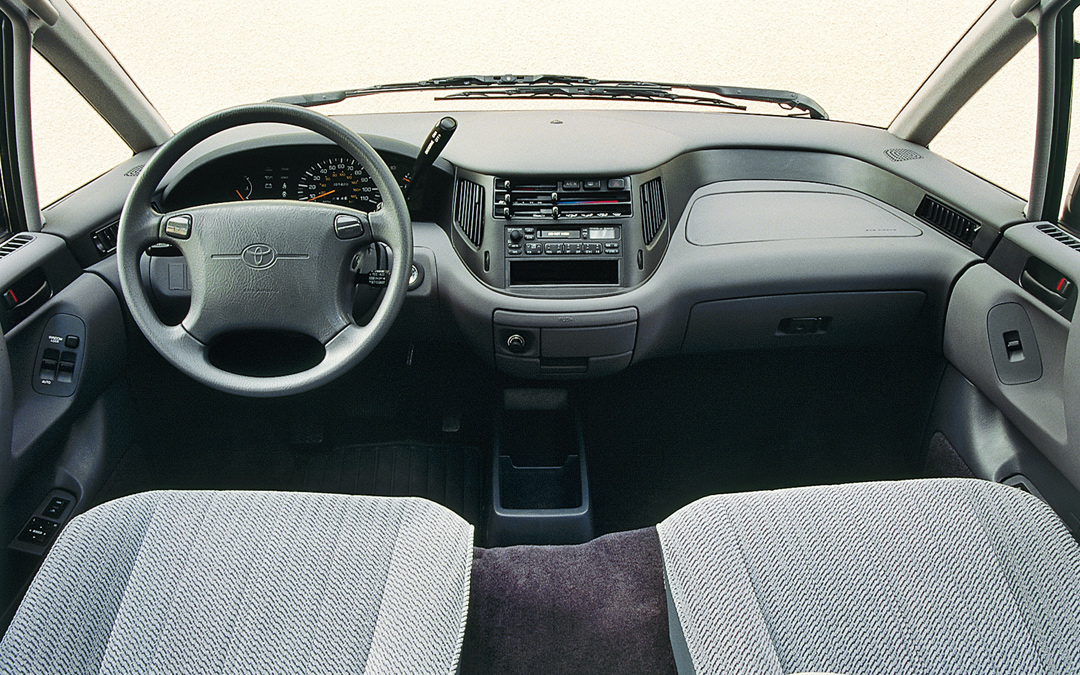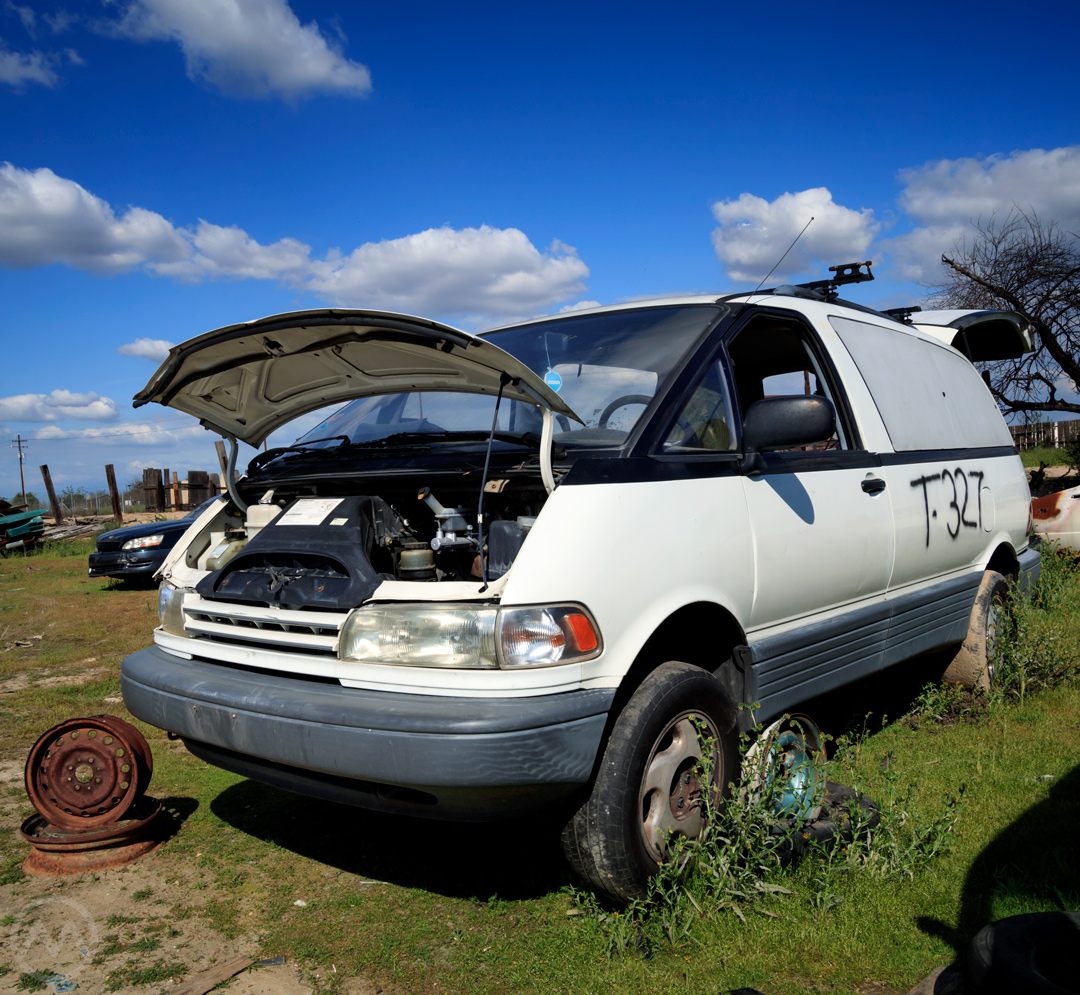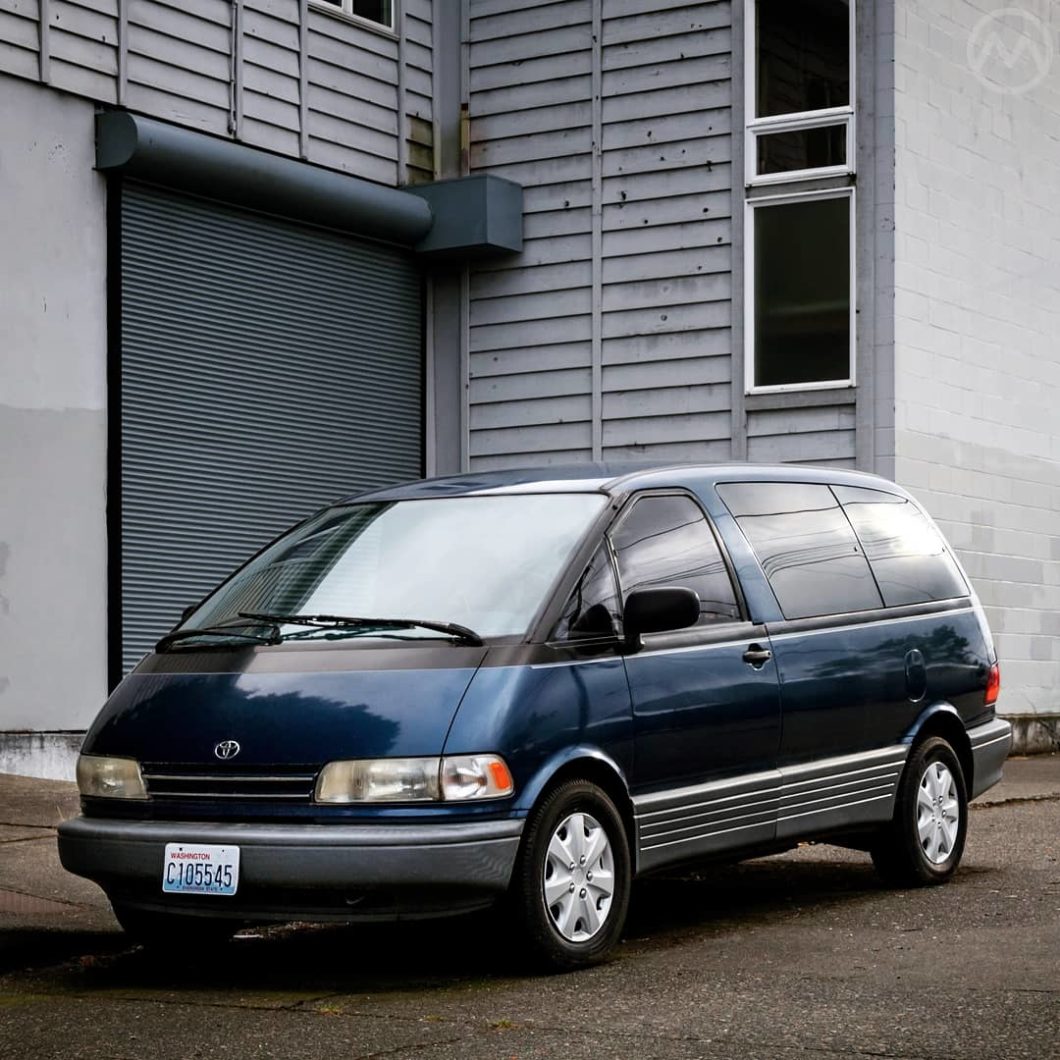Space. In a minivan, you want to be in the top tier. These are the voyages of the Starship Previa. It’s ongoing mission? To seek out strange new worlds and … new shops at the Fort Lucenne Mall. To boldly go where no van has gone before!
Minivans are familiar and formulaic today – a box with wheels, almost uniformly the same size, typically with a very specific mechanical layout. But it wasn’t always that way. Minivans didn’t really become “all the same” until the late 1990s. The first decade of minivans, by contrast, was a flourish of different approaches to the people-mover problem.
By far, the Toyota Previa was the most unusual of this new breed of vans – a radical egg-shaped lozenge with its engine in the middle and an optional supercharger (at times).
The design patents for the original Previa were filed on Christmas eve, 1987, when minivans were still a very new idea, but the story begins a little earlier.
The Age of the Minivan
Chrysler’s original minivans (the Dodge Caravan and Plymouth Voyager) and Renault’s Espace had been on the market for only four years in 1987.
The concept was immediately and enormously popular, particularly in America, though Renault’s version never made it over the pond. American Motors, then owned by Renault, did show Americanized-Espace concepts, but Chrysler dominated the early days and by the time a U.S. Espace started to emerge, Renault was in the process of offloading AMC.
Like any new idea, the minivan took a while before the product reached “maturity.” What’s a “mature” product? A formula that dominates the market and then becomes the default – like twin-engine jet airliners.
Chrysler and Renault (via Matra) had created front-wheel drive vans with transverse engines and many car components. They felt and drove like cars. Ford and GM, in the USA, created new truck-like small vans using off-the-shelf truck components incorporated into new structural designs – the Aerostar and the Astro/Safari.
Those products bought time until they could develop car-based vans, which GM got to first in 1990 with the “Dustbusters.” The Aerostar eventually gave way to the Windstar and the Mercury Villager/Nissan Quest (developed as a joint venture), all in the mold of the Chrysler minivans.
Japanese manufacturers rushed reworked upright, semi-commercial JDM vans to market – namely the Toyota Van (LiteAce), Nissan Van (Vanette), and Mitsubishi Wagon (Delica), also as theoretical stopgaps. Mitsubishi never developed a minivan for the USA, while Nissan teamed up with Ford.
Europe took longer. Volkswagen already had a minivan in the Vanagon, but it was an old-school van-like machine, and so was its replacement, the Eurovan/T4 Transporter. In a move similar to it’s deal with Nissan, Ford teamed up with VW and designed Chrysler-like minivans for Europe, the Sharan/Galaxy/Seat Alhambra, but that was in 1995. PSA Peugeot-Citroën and Fiat released Chrysler/Renault-style minivans in 1994.
In the late 1980s both SUVs and minivans competed for family buyers on more or less even terms, and manufacturers were willing to spend big to secure their slice of the pie. As the 1990s wore on, SUVs eventually overtook Minivans – but they still remained a huge segment on both sides of the Atlantic.
Genesis of the Toyota Previa
Toyota’s LiteAce was reworked for the USA even before the Chrysler minivans broke cover, and it proved durable and useful, but Americans were not fans of Forward-control old-style vans. It wasn’t a big seller. But it gave Toyota time to come up with something it hoped would be able to take on the Chrysler and Renault products head on internationally and be better in a variety of ways.
Work began on what became the Previa in 1985.
The LiteAce had its engine between the front seats, above and just aft of the front axle. It intruded quite a bit into the cabin, which wasn’t ideal compared to the low-floor Chryslers. This was much like a big Detroit van setup, just with the engine a little further back.

It might not have been the ideal starting place, but Toyota stuck with this essential concept – moving the engine backward and down for the Previa. It would be a mid-engined setup, driving the rear wheels or, later, with all-wheel drive.
To keep the floor low and maximize space – which is what Minivans are all about – the Previa’s four-cylinder engines would be mounted at a radical 75-degree slant.
This setup made the Previa a very neutral handler and really did make it very spacious with little mechanical intrusion, but it had several downsides. First, even though the floor was lower than the LiteAce, it was still high compared to the Chrysler Minvans. Furthermore, it restricted the flexibility of the platform – once it was designed, it was hard to upgrade because space was so limited.
Toyota specifically designed it’s 2TZ 2.4-liter four to fit the Previa, because nothing else would fit. After it was released, it seemed unwise to try and shoehorn anything else in after Nissan’s experience with putting a too-big engine into it’s U.S. van. The result of that was a series of fires and a high-profile buy-back. But Chrysler’s minivans, and many others, offered V6 power and the Previa did not.
In 1994, the lack of power gave rise to a supercharged version of the Previa. That’s right – a supercharged, mid-engine minivan with, at the time, an available manual transmission. Flourish. The restrictive engine bay would also fit one of the small diesel fours in the LiteAce, but that was irrelevant for the USA, which was supposed to be one of the Previa’s biggest markets. By 1990, Americans just didn’t buy diesels anymore.
While the mechanical pieces took shape mostly in Japan, the styling was done mainly in California. The final design was the work of David Doyle and Tokuo Fukuichi. Fukuichi would eventually become Toyota’s chief designer. The “Jellybean” look was accomplished with tight tolerances and lots of glass.
The Previa Swings … And Misses
Designed mostly in mid-1986, some of the early proposals kept some of the old LiteAce’s body side lines, and one, proposal B1, looked a little like the much later Sharan/Galaxy/Alhambra of a decade later. That should tell you how far out this familiar-today shape was at the time.
It was even more of a space alien than GM’s “Dustbusters,” which were themselves considered very radical looking when they debuted a few months before the Previa.

Inside, it looked just as futuristic. The 1990 Previa’s dashboard could be something from a car of the late 2000s or even early 2010s. Though the plastics would look a little dated, the central cluster and instrument pod would not – the Previa really was a show car come to life when it was new.
The open, airy interior, sometimes with two skylights, the slim A-pillars, and sculpted interior shapes made it feel as futuristic as it looked. All that glass, by the way, cost a fortune to tool up for and then another fortune for the customer if something got broken. In 1980s Japan, the sky was the limit and Toyota was willing to push the envelope.
The design was locked down in early 1988 and reached customers in late 1990 as a 1991 model.
Everything about the Previa was basically likable and the shape generated endless amounts of interest – but not that many buyers. It was too radical for most people, and while stylish, most customers don’t buy minivans for style reasons.
There was also another demerit – as other manufacturers started adding dual sliding rear doors, Toyota stuck only with a starboard-side door, even though the tooling existed to give the van a sliding door on both sides (JDM vans had a sliding door in the port side). And, again, no V6. The belated supercharger gave it more power but did little to boost its chances – by then a new generation of Chrysler vans were on the scene.
The Previa wasn’t just for North America and it had a JDM sister for dealer network reasons – the Estima. Both were fairly big vans by JDM standards, so Toyota eventually created narrow-body, slightly shorter versions of the Estima called the Lucida and the Emina.
These versions were much cheaper to tax in Japan, and they were also popular as export models to countries that didn’t want something quite as big as the Previa. In the U.K., both versions were available at different times or by import, but the Previa never made a big mark in Europe or the U.K.

The “blower” Previa was the last major upgrade for North America. The vans hung on into 1999 in Japan and even got a direct replacement, but Toyota USA wanted something different. In late 1997, the very radical Previa was replaced by the Camry-based, Chrysler-like Mk1 Sienna.
When it was new, the Previa earned considerable praise for its handling and its build quality – the latter is still being felt today. Bank-vault solid, many Previas survive today and often have interstellar mileages, with no need for help from Geordi La Forge.

